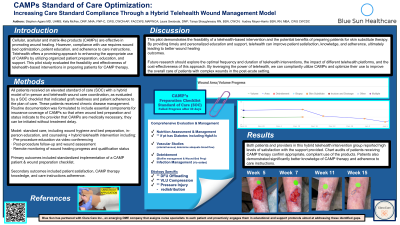Evidence-Based Practice
(EBP-019) Camps Standard of Care Optimization: Increasing Care Standard Compliance Through a Hybrid Telehealth Wound Management Model
Friday, May 2, 2025
7:45 PM - 8:45 PM East Coast USA Time

Cheryl Carver, LPN; Kristen Elizabeth Hameline, BSN; Kelly McFee, DNP; Jacqueline Mongusu, MSN; Audrey MoyerHarris, BSN; Erica Robinson, LPN; MyerAnn Royce Mangalino, DNP; Yisel Ruiz, MSN; Tanya Shaughnessy, BSN; Monica Trujillo, BSN
Introduction: Cellular tissue products (CTPs) are effective in promoting wound healing. However, compliance with use requires wound bed optimization, patient education, and adherence to care instructions. Telehealth offers a promising approach to enhance appropriate CTP use utilizing organized patient preparation, education, and support. This pilot evaluated the feasibility and effectiveness of telehealth-based interventions to prepare patients for CTP therapy.
Methods: All patients received an elevated standard of care with a hybrid model of in-person and telehealth wound care coordination evaluated with a SOC checklist indicating graft readiness and trending patient adherence to plan of care. These patients received chronic disease management. Routine documentation was formulated to include essential components for insurance coverage of CTPs so that when wound bed preparation and status indicate to the provider that CTPs are medically necessary, they can be initiated without treatment delay.
Model: standard care, including wound hygiene and bed preparation, in-person education and counseling + hybrid telehealth intervention including:
· Pre-procedure education via video conferencing
· Post-procedure follow-up and wound assessment
· Remote monitoring of wound healing progress and qualification status
Primary outcomes included standardized implementation of a CTP patient & wound preparation checklist. Secondary outcomes included patient satisfaction, CTP therapy knowledge, and care instructions adherence.
Results: Both patients and providers in this hybrid telehealth intervention group reported high satisfaction levels with the support provided. Chart audits of patients receiving CTP therapy confirm appropriate, compliant use of the products. Patients also demonstrated significantly better knowledge of CTP therapy and adherence to care instructions.
Discussion: This pilot demonstrates the feasibility and potential benefits of a telehealth-based intervention to prepare patients for skin substitute therapy. By providing timely and personalized education and support, telehealth can improve patient satisfaction, knowledge, and adherence, ultimately leading to better wound-healing outcomes.
Future research should explore the optimal frequency and duration of telehealth interventions, the impact of different telehealth platforms, and the cost-effectiveness of this approach. By leveraging the power of telehealth, we can not only compliantly utilize CTPs but optimize their use to improve the overall care of patients with complex wounds in the post-acute setting.
Methods: All patients received an elevated standard of care with a hybrid model of in-person and telehealth wound care coordination evaluated with a SOC checklist indicating graft readiness and trending patient adherence to plan of care. These patients received chronic disease management. Routine documentation was formulated to include essential components for insurance coverage of CTPs so that when wound bed preparation and status indicate to the provider that CTPs are medically necessary, they can be initiated without treatment delay.
Model: standard care, including wound hygiene and bed preparation, in-person education and counseling + hybrid telehealth intervention including:
· Pre-procedure education via video conferencing
· Post-procedure follow-up and wound assessment
· Remote monitoring of wound healing progress and qualification status
Primary outcomes included standardized implementation of a CTP patient & wound preparation checklist. Secondary outcomes included patient satisfaction, CTP therapy knowledge, and care instructions adherence.
Results: Both patients and providers in this hybrid telehealth intervention group reported high satisfaction levels with the support provided. Chart audits of patients receiving CTP therapy confirm appropriate, compliant use of the products. Patients also demonstrated significantly better knowledge of CTP therapy and adherence to care instructions.
Discussion: This pilot demonstrates the feasibility and potential benefits of a telehealth-based intervention to prepare patients for skin substitute therapy. By providing timely and personalized education and support, telehealth can improve patient satisfaction, knowledge, and adherence, ultimately leading to better wound-healing outcomes.
Future research should explore the optimal frequency and duration of telehealth interventions, the impact of different telehealth platforms, and the cost-effectiveness of this approach. By leveraging the power of telehealth, we can not only compliantly utilize CTPs but optimize their use to improve the overall care of patients with complex wounds in the post-acute setting.

.jpg)